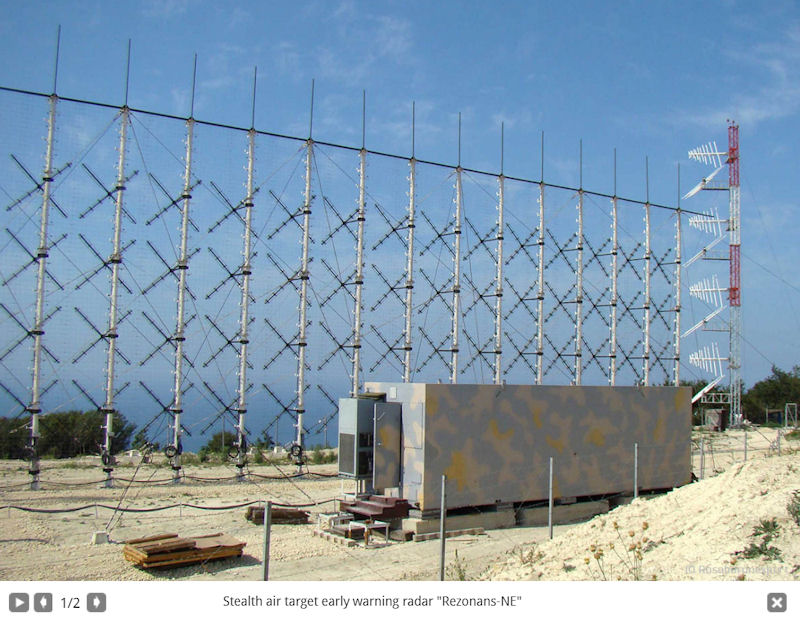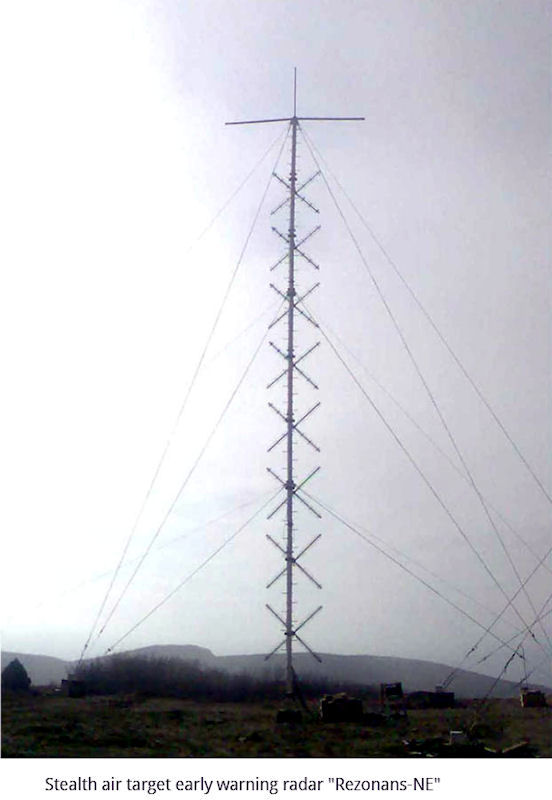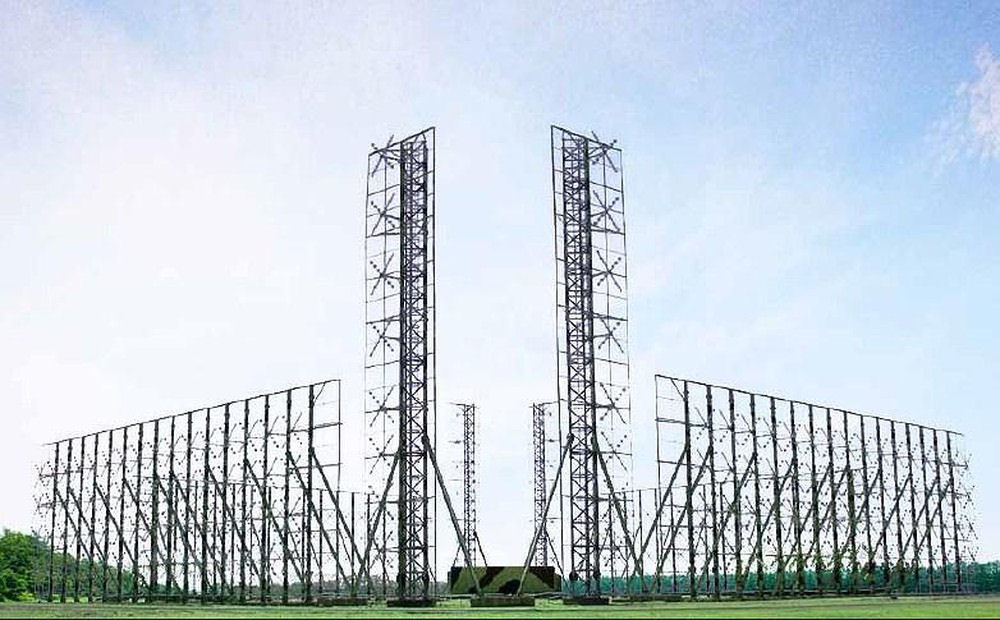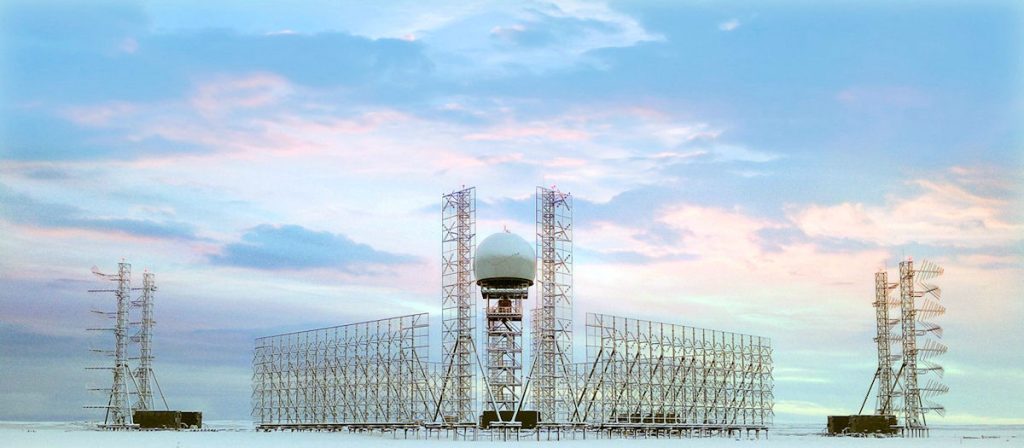
LINK TO ARTICLE A Russian publication reported this week that the Russian Armed Forces have deployed their Resonance radar system in an area near the Israeli border.
The meter range radar system allows the detection and recognition of various air targets at long ranges. Resonance-N (NE) is capable of detecting such an air target as a fighter at an altitude of up to 10 thousand meters at a distance of 350 km. According to other sources, the range exceeds 400 km. The maximum detection range is 1100 km. At the same time, the complex is capable of simultaneously tracking and tracking up to 500 targets, including targets that are accomplished using the technology of low radar signature (stealth). The resolution of Resonance-N is such that it allows the detection and identification of virtually any aircraft, including cruise missiles.
The Rezonans-NE very high frequency [VHF] counter-stealth early warning phased-array radar is designed to effectively detect a wide range of current and future air targets, including low-observable cruise and ballistic missiles, hypersonic aerial vehicles, as well as stealthy ones, in severe electronic countermeasures (ECM) and clutter environment. It is in service with the Russian Air Force, Iran (since 2009) and Algeria (since 2017).
The radar can operate in circular scan mode or within a specified sector. In addition to peacetime tasks, it can provide early warning of an air attack and information support for air and air defense warfare operations. The Rezonans-NE includes up to four radar modules, each of which provides control in the azimuth sector of 90 degrees and can operate independently.
The radar can operate in circular scan mode or within a specified sector. In addition to peacetime tasks, it can provide early warning of an air attack and information support for air and air defence warfare operations. The Rezonans-NE includes up to four radar modules, each of which provides control in the azimuth sector of 90 degrees and can operate independently.
The radar module consists of a transmit antenna-feeder device, receive azimuth and elevation antenna-feeder devices, and a power amplifier. The radar’s data receiving and processing system provides data reception and processing in each of the four modules. Radar equipment is housed in containers. The probing signal generator and radar data receiving and processing equipment are digital and controlled by special processors. A solid power amplifier is used. The radar consisting of the four modules controls the 360-degree sector and occupies a 100 x 100 m area.
- detect and track a wide range of air targets at long ranges, including small and stealthy ones;
- automatically determine the location and motion parameters of air targets as well as classify them;
- automatically provide designations to weapon systems;
- generate and send information about the tracked targets for taking operational decisions;
- analyze the ECM situation and automatically adjust to the actual ECM conditions.
In the Arctic, Russia deployed a radar complex “Resonance-N” with elements of artificial intelligence. According to the Ministry of Defense, the station entered service with the Northern Fleet at the end of 2018. The complex is designed for the long-range detection of a wide range of modern air objects. It is also able to classify aircraft created using stealth technology, mini-UAVs and hypersonic devices. The station’s capabilities are greatly enhanced by the phased array antenna, in addition, the locator can automatically exchange information with other radars in automatic mode. The range of “Resonance” – 1100 km, is able to provide target designation of air defense systems, located at a distance of 600 km.
A feature of the complex is the absence of rotating antennas in its design: a circular view of the space is conducted by electronic means. This increases the reliability of locators, increases their lifespan and reduces power consumption. The station was built using only Russian components. Resonance-N has been specially upgraded to work in arctic conditions.
According to the ex-chief of the anti-aircraft missile forces Alexander Gorkov, the tasks of the North command in the Arctic, first of all, include the protection of the forces of the Northern Fleet and its nuclear fleet, as well as ensuring the security of industrial regions of Central Russia, the Urals and Siberia. It is noted that new formations are practically restoring the infrastructure that existed in the Arctic during Soviet times. Then there served the 10-I army of air defense. However, in the nineties, it was disbanded.
Carlo Kopp noted in 2010 that the VHF band Rezonans N/NE, which is explicitly marketed as “Stealth Air Target Early Warning Radar.” Like the Nebo U/UE series, it takes 24 hours to deploy and is intended for static long-range air defense applications. Production quantities remain unknown at this time. Unlike the Nebo U/UE, it uses electronic beam steering techniques.
The third in the Russian Arctic, the Resonance-N radar, capable of detecting stealth aerial objects, cruise missiles, ballistic and hypersonic targets, will take up combat duty on the Novaya Zemlya archipelago in November 2019. This was announced to TASS on 24 October 2019 by the Director General of the Resonance Research Center Ivan Nazarenko. “The third in the Arctic, the Resonance-N radar is deployed on Novaya Zemlya. The radar will take up combat duty this November,” he said. Nazarenko added that the station is already on, configured and ready for combat use, an interdepartmental commission is currently working to accept and transfer it to the Northern Fleet air defense.
According to him, to date, the Russian military received four Resonance-N stations, the fifth is at the stage of completion. Two stations are already on duty. “The task of all radars is to cover the northern direction in the Arctic,” Nazarenko said. “The meter wavelength range of the station allows us to detect aircraft made using stealth technologies and hypersonic targets flying at speeds of up to 20 Mach, because when using it, there is a resonant increase in the effective reflective surface of aircraft,” the director general said.
The radar is capable of detecting and providing target designation for aerodynamic air targets at a range of 600 km, for ballistic targets – up to 1200 km, in height up to 100 km. The first Resonance-N radar was put on combat duty in Russia five earlier.
In November 2019, in the Arctic on the archipelago of Novaya Zemlya, the third in a row radar complex “Resonance-N” enters combat alert. He will be able to detect ballistic objects of any complexity, as well as cruise missiles, hypersonic targets and aircraft created using the stealth technology under the conditions of electronic counteraction and natural interference.
The radar system was already on and is in test mode. In the near future, it would be transferred to the units of the radio engineering troops of the 45th Army of the Air Force and Air Defense, which is part of the Northern Fleet. In total, Russian air defense in the Arctic region should acquire four such resonances “Resonance-N”. Two of them were already on alert.
The new complex was specially modernized to operate in the Far North. It will seriously enhance the combat capabilities of the anti-aircraft group in the Arctic region, through which it is most convenient for a likely enemy to strike in areas of the Urals, Siberia and Central Russia.
The technical capabilities of the Resonance-N radar allow it to detect and issue target designations for aerodynamic air targets at ranges up to 600 km, for ballistic targets – up to 1200 km. At the same time, he discovers targets at altitudes of up to 100 km.
The radar “Resonance-N” is developed on a modular basis. This significantly reduces the cost of its production due to the subsequent assembly of special containers, in which all nodes of the station are located. In the end, this allows you to make the station quite mobile.
Ready containers from manufacturers are delivered by road, rail, water or air to the place of subsequent installation on pre-prepared foundations. If necessary, this radar can be transported very quickly and mounted in a new location. And if necessary, it is also quickly modified to build up combat capabilities by embedding similar containers from the stations of the same type.
Phased antenna array significantly expands the capabilities of the complex, and the locator can automatically exchange data with other radars. The radar station fits on a site measuring 100 by 100 meters. It controls the airspace around in a circular mode, with a 360-degree view. The station is equipped with a friend-or-foe target recognition system and can operate stably both at the lowest and highest air temperatures, with wind speeds up to 50 m / s.
At the same time, the radar is capable of tracking over 500 targets, providing early warning of an air attack and providing information about the air situation to aviation and anti-aircraft defense systems during combat operations.
A feature of the radar complex is the absence of rotating antennas, which are usually used to provide all-round visibility. Here, a circular overview is carried out using electronic means of space control. This significantly reduces the energy supply necessary for the operation of the complex, increases the resource and increases the reliability of the locator. The radar does not lose effectiveness in conditions of electronic counteraction or strong natural interference.
It is important that in the coverage area of the radar complex, all aircraft created using the technology to reduce radar visibility are visible. All this is due to the fact that the Resonance-N radar implements the principle of resonant radar to detect a wide class of air targets. The method has been worked out and tested on various mathematical models both in the field and at the test sites, where it is fully justified.
In the export version, Resonance-NE is supplied to other countries of the world. So, the Egyptian Resonance-NE radar tracks the movement of all objects in the airspace not only over Egypt, but also Israel and Syria. According to a number of sources, in 2020 Russia will begin regular deliveries of Resonance-NE to the Middle East.
Main characteristics
| Coverage area: | |
| range, km | 10-1100 |
| azimuth, deg | 360 |
| elevation, deg | 1,5 to +80* (0 to +80)** |
| altitude, km | ±100 |
| Fighter detection range at altitude of 10,000 m, km | |
| Target location accuracy, not worse than: | |
| range, m | 300 |
| azimuth, deg | 1,5 |
| elevation, deg | 1,5 |
| speed, m/s | 1-1,5 |
| Data update rate, s | 1-10 |
| Number of tracked targets | ±500 |
| Operation time mode | continuously*** |
| Warm-up time (on a prepared site with installed AFD), min | 10 |
| Operating crew (one shift) | 3 |
| Power supply system | self-contained industrial network 3 x 220 VAC, 50 Hz |
| Power consumption, kW | 100 |
| Operation conditions: | |
| ambient temperature, °C | -40° to +50° |
| relative air humidity, % | = 90 at 25 °C |
| wind speed, m/s | = 50 |
| Transportation | by road, rail, sea, air |
Last year, the think tank and reputable military analysis source GlobalSecurity.org wrote: “the Egyptian Resonance-NE radar tracks the movement of all objects in the airspace not only over Egypt, but also Israel and Syria. According to a number of sources, in 2020 Russia will begin regular deliveries of Resonance-NE to the Middle East.”







